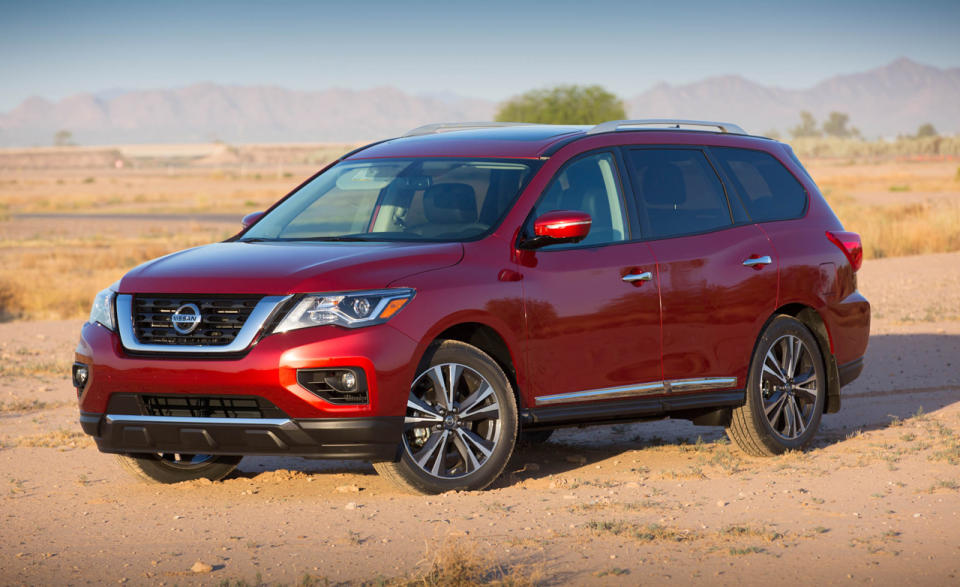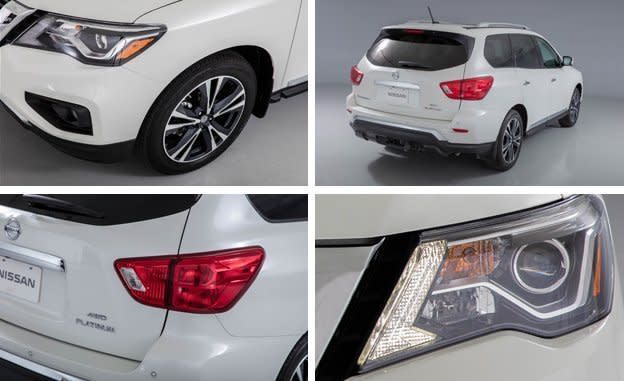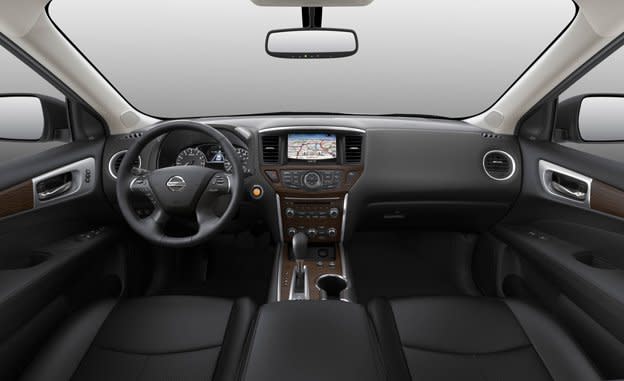2017 Nissan Pathfinder Mostly Stays on Path

Celebrating 30 years on the market, the Nissan Pathfinder enters 2017 with a fresh face, a reworked powertrain, improved dynamics, and new safety and technology features.
Looking like the love child of Nissan’s own Rogue compact crossover and the competing Ford Explorer, the updated Pathfinder wears a more butch, squarer face that incorporates the latest Nissan design cues, including the brand’s V-Motion grille and boomerang-shaped LED daytime running lights, which are standard on all four models (S, SV, SL, and Platinum). The top-spec Pathfinder Platinum also gets LED headlights, while lesser models continue with halogens. In back, a new bumper cover and taillight lenses, along with a motion-activated liftgate, differentiate the 2017 Pathfinder from last year’s version.

Aerodynamic revisions, bringing the three-row crossover’s drag coefficient down a smidge to 0.33 from an already respectable 0.34. For reference, the slick and fuel-efficient new Mazda CX-9 cuts through the air with a 0.35 Cd. The Pathfinder’s smooth shape pays dividends at the pump: Nissan expects the mid-size crossover to maintain its EPA fuel-economy figures of 20 mpg city and 27 mpg highway for front-wheel-drive models and 19/26 with all-wheel drive, despite offering 24 more horsepower and 19 additional lb-ft of torque from a significantly revised engine.
Nissan claims that more than half of the parts in the Pathfinder’s 3.5-liter V-6 are new. Dubbed VQ35DD, the latest iteration of the VQ engine makes a healthy 284 horsepower and 259 lb-ft of torque here. Paired with Nissan’s latest continuously variable automatic transmission, a unit the company characterizes as “similar” to the one in the new Maxima, the new powertrain allows a tow rating of up to 6000 pounds, an increase of 1000 pounds.
Ultimately, though, the Pathfinder is a family vehicle, and Nissan worked to improve the three-row crossover’s ability to tote people to and fro in comfort and safety. Stiffer front and rear dampers team with a handful of other suspension enhancements to reduce body roll, and the steering is quicker. Meanwhile, safety tech such as automated emergency braking and adaptive cruise control are newly available—but on the top-spec Platinum only. Nissan’s 360-degree-view camera system adds moving-object detection to its resume but is not available on S and SV models.

Inside, all 2017 Pathfinders now come standard with an improved color display in the gauge cluster, plus an eight-inch center-mounted touchscreen (an inch larger than last year). Navigation is standard on the top-level Platinum, optional on the SL and SV, and not available on the base Pathfinder S, while the Pathfinder Platinum is the only model that offers the option of a rear entertainment system, including a pair of headrest-mounted screens; at eight inches, these displays also are an inch larger than before.
With capability and features that are in line with its three-row, family-hauling competitors, it’s hard to say that the 2017 Nissan Pathfinder truly blazes its own trail, but Nissan’s latest updates should prevent it from falling behind in the segment. Pricing for the 2017 Pathfinder has not yet been released, but we don’t expect the revised vehicle—which goes on sale in September—to stray too far from its current $30,730 base.

 Yahoo Autos
Yahoo Autos 